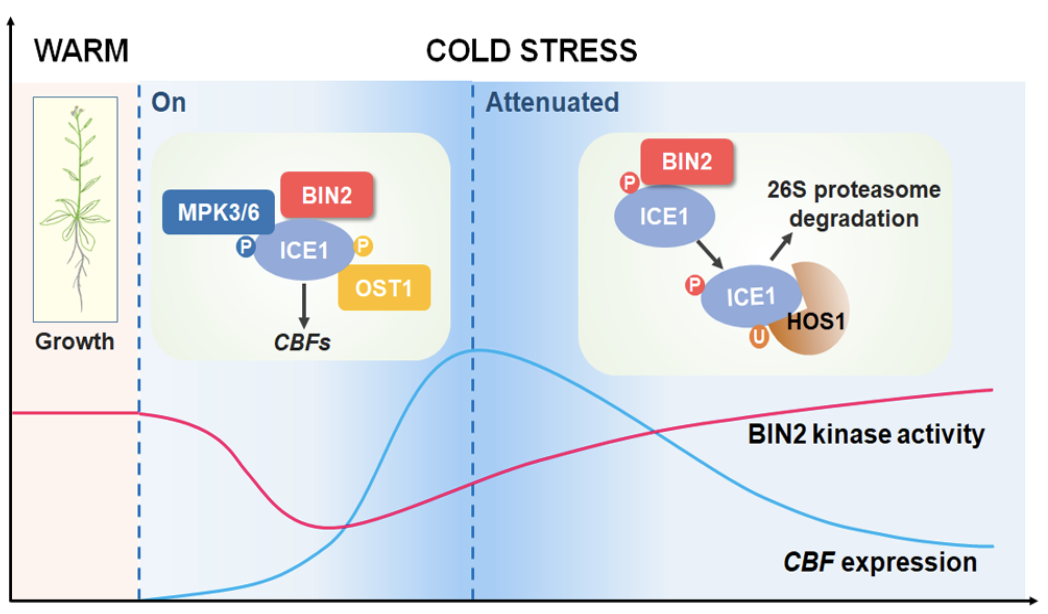博文
Plant Cell:植物低温响应后期的生长恢复机制
||
BRASSINOSTEROID-INSENSITIVE2 Negatively Regulates the Stability of Transcription Factor ICE1 in Response to Cold Stress in Arabidopsis
First author: Keyi Ye; Affiliations: China Agricultural University (中国农业大学): Beijing, China
Corresponding author: Shuhua Yang
Cold acclimation is a crucial strategy for plant survival at freezing temperatures. CBF (C-REPEAT BINDING FACTOR) genes are rapidly and transiently induced by low temperature and play important roles in cold acclimation. However, the mechanism underlying the attenuation of CBF expression during the later stages of the cold stress response is obscure. Here, we show that the protein kinase BIN2 (BRASSINOSTEROID-INSENSITIVE2) interacts with and phosphorylates ICE1 (INDUCER OF CBF EXPRESSION1) in Arabidopsis under prolonged cold stress, facilitating the interaction between ICE1 and the E3 ubiquitin ligase HOS1 and thereby promoting ICE1 degradation. The kinase activity of BIN2 is inhibited during the early stages of the cold stress response and is subsequently restored, suggesting that BIN2 mainly downregulates ICE1 abundance when CBF expression is attenuated. A loss-of-function mutant of ICE1 partially suppresses the cold-induced expression of CBFs and compromises the enhanced freezing tolerance of bin2-3 bil1 bil2. These findings reveal an important role for BIN2 in fine-tuning CBF expression, and thus in balancing plant growth and cold acclimation.

低温适应是植物在冻结温度下存活的关键策略。C-重复结合因子CBF基因能够快速并瞬间受到低温的诱导,在植物适应低温的过程中发挥重要作用。然而,在低温胁迫响应的后期CBF基因的表达是通过何种机制减弱的还不清楚。本文的研究显示在拟南芥长期受到低温胁迫时,蛋白激酶BIN2能够与ICE1互作,并磷酸化ICE1,促进ICE1与E3泛素连接酶HOS1的互作,从而加速ICE1的降解。BIN2的酶活在低温胁迫响应早期是被抑制的,随后逐渐被恢复,说明BIN2主要在CBF表达减弱的时候下调ICE1的丰度。ICE1的功能缺失突变体部分抑制了低温诱导的CBF表达,并且减弱bin2-3 bil1 bil2突变体增强的低温抗性。本文的发现揭示了一个BIN2精确调控CBF表达的分子机制,对于平衡植物生长和低温适应十分重要。
通讯:杨淑华 (http://cbs.cau.edu.cn/art/2018/9/14/art_31816_594296.html)
个人简介:1987-1991年,南开大学,学士;1991-1994年,南开大学,硕士;1998-2002年,新加坡国立大学,博士;2002-2004年,美国康奈尔大学,博士后。
研究方向:植物感知和响应低温胁迫的分子机理。
doi: https://doi.org/10.1105/tpc.19.00058
Journal: Plant Cell
First Published: August 13, 2019

https://blog.sciencenet.cn/blog-3158122-1193848.html
上一篇:Nature Physics:细胞大小限制了细胞的极性和不对称分裂
下一篇:PNAS:自然群体中大效应突变存在的理由~增加特定环境条件下的适应性
全部作者的其他最新博文
- • Plant Physiology:CsMADS3促进柑果中的叶绿素降解和类胡萝卜素合成(华中农业大学)
- • Molecular Plant:LBD11-ROS反馈调节作用于拟南芥的维管形成层增殖和次生生长(浦项科技大学)
- • Science Advances:根结线虫通过调控植物的CLE3-CLV1模块,促进侵染进程(日本熊本大学)
- • Nature Communications:油菜素内酯参与植物营养生长期转变的分子机制解析(浙江农林大学)
- • Current Biology:光合作用产生的蔗糖驱动侧根“生物钟”(德国弗莱堡大学)
- • PNAS:花同源异型基因在叶中被抑制、花中被激活的分子机制(南卡罗来纳大学)